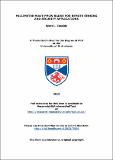Files in this item
Millimetre-wave FMCW radar for remote sensing and security applications
Item metadata
| dc.contributor.advisor | Robertson, Duncan Alexander | |
| dc.contributor.advisor | Smith, Graham Murray | |
| dc.contributor.author | Cassidy, Scott L. | |
| dc.coverage.spatial | xiii, 169 p. | en_US |
| dc.date.accessioned | 2015-11-26T16:51:39Z | |
| dc.date.available | 2015-11-26T16:51:39Z | |
| dc.date.issued | 2015-11-30 | |
| dc.identifier | uk.bl.ethos.675216 | |
| dc.identifier.uri | https://hdl.handle.net/10023/7856 | |
| dc.description.abstract | This thesis presents a body of work on the theme of millimetre-wave FMCW radar, for the purposes of security screening and remote sensing. First, the development of an optimised software radar signal processor will be outlined. Through use of threading and GPU acceleration, high data processing rates were achieved using standard PC hardware. The flexibility of this approach, compared to specialised hardware (e.g. DSP, FPGA etc…), allowed the processor to be rapidly adapted and has produced a significant performance increase in a number of advanced real-time radar systems. An efficient tracker was developed and was successfully deployed in live trials for the purpose of real-time wave detection in an autonomous boat control system. Automated radar operation and remote data telemetry functions were implemented in a terrain mapping radar to allow continuous monitoring of the Soufrière Hills volcano on the Caribbean island of Montserrat. This work concluded with the installation of the system 3 km from the volcano. Hardware modifications were made to enable coherent measurement in a number of existing radar systems, allowing phase sensitive measurements, including range-Doppler, to be performed. Sensitivity to displacements of less than 200 nm was demonstrated, which is limited by the phase noise of the system. Efficient compensation techniques are presented which correct for quadrature mixer imbalance, FMCW chirp non-linearity, and scanner drive distortions. In collaboration with the Home Office, two radar systems were evaluated for the stand-off detection of concealed objects. Automatic detection capability, based on polarimetric signatures, was developed using data gathered under controlled conditions. Algorithm performance was assessed through blind testing across a statistically significant number of subjects. A detailed analysis is presented, which evaluates the effect of clothing and object type on detection efficiency. | en_US |
| dc.language.iso | en | en_US |
| dc.publisher | University of St Andrews | |
| dc.subject | Radar | en_US |
| dc.subject | Millimetre wave | en_US |
| dc.subject | Sub-millimetre | en_US |
| dc.subject | FMCW | en_US |
| dc.subject | Coherent | en_US |
| dc.subject | Doppler | en_US |
| dc.subject | Vibrometry | en_US |
| dc.subject | Chirp nonlinearity | en_US |
| dc.subject | Phase noise | en_US |
| dc.subject | Imaging | en_US |
| dc.subject | Concealed object detection | en_US |
| dc.subject | Anomaly detection | en_US |
| dc.subject | Polarisation | en_US |
| dc.subject | Remote sensing | en_US |
| dc.subject | Tracking | en_US |
| dc.subject | Signal processing | en_US |
| dc.subject | Threading | en_US |
| dc.subject | GPU | en_US |
| dc.subject.lcc | TK6592.C65C2 | |
| dc.subject.lcsh | Continuous wave radar | en_US |
| dc.subject.lcsh | Remote sensing | en_US |
| dc.subject.lcsh | Scanning systems | en_US |
| dc.subject.lcsh | Security systems--Remote sensing | en_US |
| dc.title | Millimetre-wave FMCW radar for remote sensing and security applications | en_US |
| dc.type | Thesis | en_US |
| dc.contributor.sponsor | Natural Environment Research Council (NERC) | en_US |
| dc.type.qualificationlevel | Doctoral | en_US |
| dc.type.qualificationname | PhD Doctor of Philosophy | en_US |
| dc.publisher.institution | The University of St Andrews | en_US |
This item appears in the following Collection(s)
Items in the St Andrews Research Repository are protected by copyright, with all rights reserved, unless otherwise indicated.

